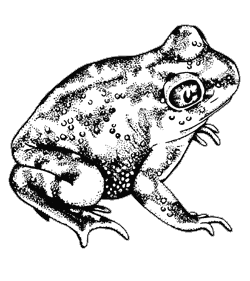Couch’s spadefoot (Scaphiopus couchi)
Order: Salientia
Family: Pelobatidae (spadefoots)
Other common name: spadefoot toad
Spanish names: sapo con espuelas
Distinguishing Features
Couch’s spadefoot is a 3 inch (8 cm), smooth-skinned, greenish, yellowish, or olive spadefoot with irregular blotches or spots of black, brown, or dark green. The belly is white and without markings. At the base of each hind foot is a dark, sickle-shaped keratinous “spade,” hence the name spadefoot. The width of the eyelids is approximately the same as the distance between the eyes. The pupils are vertical.

Though often called spadefoot toads, spadefoots are not true toads and should therefore simply be called spadefoots.
Range
In the southwestern United States, Couch’s spadefoots range from southeastern California through southern Arizona and southern New Mexico. They continue into all of Texas, except the extreme north and east, and northward to southwestern Oklahoma. In Mexico, this frog is distributed along eastern Baja California and on the western and eastern coasts of mainland Mexico south to Nayarit and southern San Luis Potosi.
Habitat
Couch’s spadefoots do well in extremely xeric (dry) conditions in areas with sandy, well-drained soils often occupied by creosote bush and mesquite trees. They are also found in short grass prairies and grasslands, cultivated lands, and along desert roadways during summer thunderstorms.
Life History
During summer monsoons, the spadefoot is well-known for emerging from its subterranean estivation to breed in the temporary ponds created by the heavy runoff. Interestingly, the cue for adult emergence during these summer thunderstorms is not moisture, but rather low frequency sound or vibration, most likely caused by rainfall or thunder. Upon emergence, males begin calling to attract females. Their calls sound like the bleating of sheep or goats. One female may lay as many as 3000 eggs. Once the eggs are laid, they must hatch quickly into tadpoles before these shallow pools disappear. And hatch quickly they do — at water temperatures of 86°F (30°C) eggs hatch in 15 hours! Tadpoles must also metamorphose quickly — 2 weeks on average, sometimes as little as 9 days — into froglets before the ponds dry up. In this exacting atmosphere very few eggs make it to young frogs.
Using the spade on the hind foot, spadefoots can quickly bury themselves in loose, sandy soil. Adult spadefoots burrow into the ground to avoid heat and desiccation, but recently metamorphosed spadefoots may be seen during and immediately after the rainy season in any moist place — under vegetation, former ponds, or moist soil. During this time young spadefoots need to eat enough food to survive the unfavorable living conditions above the surface of the ground. After eating as much as possible, they too burrow beneath the surface. Breeding may not occur in years with insufficient rainfall. Preying primarily upon beetles, grasshoppers, katydids, ants, spiders, and termites, a spadefoot can consume enough food in one meal to last an entire year!
Comments
Couch’s spadefoots have a skin secretion that may cause allergic reactions in some humans. Cuts and scratches may become painful, and sneezing and discharge from the eyes and nostrils may also result from the handling of this amphibian.










